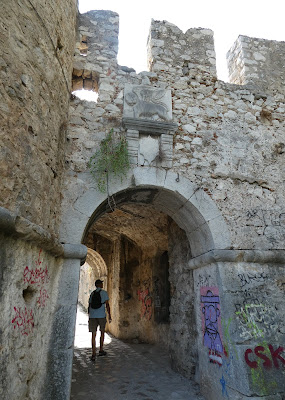The period between our return from Lyon on August 23 and the beginning of our trip to Greece on September 4 was a rather painful one for me, which in turn, created some anxieties about the upcoming travel. I had slipped on one of our interior stairways on August 18 and landed hard on my left heel. My ankle was a bit painful when we were in Lyon, but didn't seem too bad, so I probably walked more on it than I should have during that trip. After our return, I started having pain in my left heel during standing and walking. It didn't seem to be getting any better over the weekend despite extensive rest, ice, elevation, and painkillers, so I made my first foray into the French medical system on Monday, August 26. I managed to find the equivalent of an urgent care doctor in Auxonne, who agreed to give me a quick examination despite the fact that I didn't have an appointment. Between my minimal French and Google Translate, she told me that it was probably just a bruise and not a break, but to be on the safe side she gave me a prescription to get an x-ray of the left heel/ankle and an ultrasound of the Achilles tendon. Again, fortunately, Auxonne has an imaging clinic, and they were able to fit me in the following morning. The doctor there spoke English and confirmed that there was no break or torn ligament. The cost for the two visits was about the equivalent of $130 total--I can't imagine anywhere in the U.S. where an uninsured patient could have obtained the services I did for a price that low.
I was happy not to have broken or cracked anything, but the continuing pain had me concerned about the impact on our trip to Greece. Our trips usually involve lots of walking, and I didn't know what kind of modifications would have to be made to our trip if my foot didn't improve. I rested it a lot, but biking didn't seem to bother it, so we made a couple of "escapes" from CARIB with rides to neighboring villages.
By the time of our departure on September 4, the foot was feeling much better, although still not 100%. The first two days were travel days, so aside from the walking required at the airports I was able to take it fairly easy. That seemed to do the trick, because by the evening of the 5th the soreness in the foot was gone. I still used an elasticized ankle support, but we walked several miles on most days, and I never had a recurrence of the pain. Hallelujah! Given what we encountered in Greece, it would have been a real challenge to travel with a bad foot.
If we had to come up with an acronym to describe our time in Greece, it might have been something like "B.O.A.T.S.: Break Out Another Thousand Steps." We're talking about the vertical ones--as in stairways--not just the horizontal ones. It's probably not surprising that anyone in Greece is going to spend a lot of time going up or down, given that the country is 80% mountainous. The ancients loved the high hills for the security they provided, and because much of our sightseeing would be to old archeological sites, it was inevitable that we would have to deal with lots of stairs and slopes.
We claimed our rental car at the Athens airport, and after 2 hours on excellent roads we were at our first stop, the city of Nafplio on the Greek Peloponnese. Although settled very early, most of the architecture and archeological sites stem from the occupations by the Franks, Venetians, and Turks. Nafplio became the first capital of Greece when it won its independence in 1823, and held that role until 1834. It is considered one of the most romantic towns in Greece, and turned out to be a great base for our explorations over the next several days.
 |
| We absolutely loved staying at the 7-room Amfitriti Palazzo Hotel. We had to park the car next to the old castle on the hill above the hotel, but it was worth every step to get to and from the hotel. |
 |
| Our breakfast view from the patio of the hotel included the oldest castle in Nafplio, the Acronafplia Castle. The breakfast buffet was awesome and the staff wonderful. |
 |
| Upper: breakfast view over the Argolikos Gulf. Lower: breakfast view inland. |
 |
| The east side had great views down to Arvanitia Beach; the water was crystal clear. The 17th C Palamidi Fortress is on the hilltop above the town and the beach. |
 |
| Stairs or slopes, the only way to change levels in Nafplio. |
 |
| Palamidi Fortress as seen from Acronafplia Castle. The stairway "switchbacks" go down the hill just below the left side of the fortress wall (hard to see). |
 |
| Lon is just about to go out of sight at the top end of the visible staircase. We did the climb fairly early in the morning when the stairway was in shade. It was still hot at the top, though. |
 |
| The climb turned out to be not too bad--as long as one took the occasional break. |
 |
| Not "OSHA approved". The U.S. lawyers would probably have a field day with some of the safety aspects of the site (or lack thereof). |
 |
| It was a big fortress, and we explored nearly every corner. |
 |
| Sidagmatos Square, the main square of Nafplio. |
 |
| On the downtown side, this is the start of the Arvanitia walk around the peninsula upon which the Acronafplia Castle sits. It ends at the Arvanitia Beach. Beautiful at dusk! |







No comments:
Post a Comment